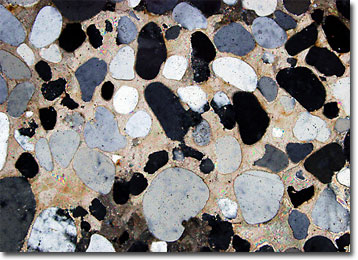Polarized Light Microscopy Digital Image Gallery
Glauconite
Glauconite is a silicate mineral typically classified as a mica, although it exhibits many qualities that differ from other members of the group. For instance, glauconite is the only mica that does not exhibit perfect cleavage.

View a second image of Glauconite
The mineral glauconite, which characteristically appears some shade of green, derives its name from the Greek word glaukos, meaning “bluish-green.” Typically found in small grains referred to as pellets, the color of the substance is a consequence of its iron content and its other constituent elements. Glauconite can be precipitated directly from marine waters or may alternatively occur via a transformation of the organic wastes of bottom-dwellers or through the underwater modification of certain clays. Presence of the mineral is responsible for the widespread greensands that occur along the bottom of the oceans, as well as many of the rocks commonly known as greenstones.
Due to its distinctive color, glauconite has been exploited for many years as a pigment, and because of its high potassium content the mineral is also often utilized as a component in fertilizers. The glauconite-rich greensands, on the other hand, are frequently used for water softeners. Commercial businesses obtain adequate quantities of these materials from various quarries located around the world.
